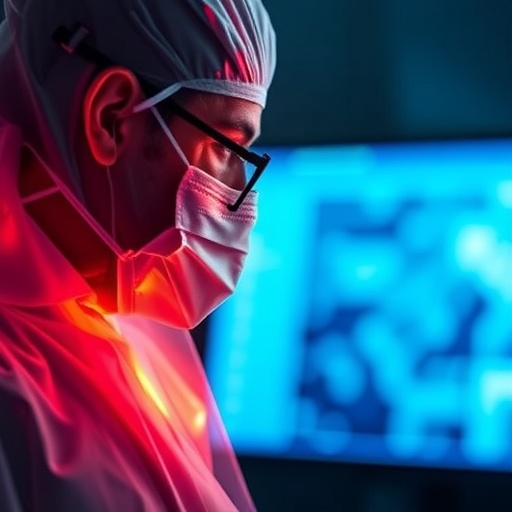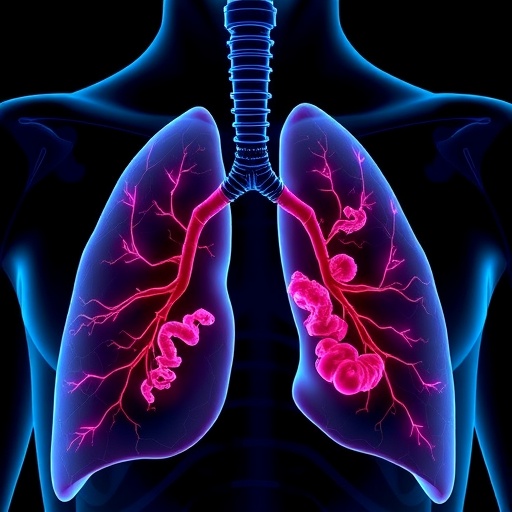In the rapidly evolving domain of oncology and medical imaging, the precision of preoperative assessments stands as a critical determinant of successful patient outcomes. A recent breakthrough study published in BMC Cancer introduces an innovative approach that synergizes computed tomography (CT) based radiomics with advanced neural network architectures to predict the infiltration status of pulmonary ground-glass nodules (GGNs) before surgery. This development holds profound implications for surgical planning and personalized therapeutic regimens, promising to diminish treatment mismatches and improve overall prognoses for lung cancer patients.
Pulmonary GGNs serve as enigmatic indicators within thoracic radiology, often manifesting with diverse pathological behaviors ranging from benign inflammation to invasive adenocarcinoma. Historically, their heterogeneous nature has posed formidable challenges in establishing optimal surgical interventions. The ability to preoperatively discern the infiltration status of GGNs would revolutionize clinical decision-making, guiding surgeons towards tailored operative procedures—lobectomy or sublobectomy—while simultaneously refining postoperative therapeutic strategies.
The cornerstone of this pioneering study lies in harnessing radiomics—a nuanced analytical technique that transforms standard medical images into high-dimensional data sets quantifying tumor phenotypes beyond human visual perception. The researchers meticulously delineated regions of interest (ROIs) on CT images within lung window settings using the ITK-SNAP platform. This process involved extracting an extensive spectrum of imaging features encompassing morphological descriptors, first-order statistical metrics, intricate texture variables, and higher-order radiomic characteristics, thereby assembling a comprehensive dataset reflective of GGN heterogeneity.
To distill the most prognostically relevant variables from this vast feature pool, the study deployed the Least Absolute Shrinkage and Selection Operator (Lasso) algorithm. This regularization method adeptly minimizes redundancy and overfitting by penalizing less significant features, allowing the model to concentrate on variables with true predictive value. The filtered characteristics were then integrated as inputs into a tailored neural network model designed to decode complex, nonlinear relationships embedded within the image-derived data.
At the algorithmic core, the neural network architecture amalgamated a three-dimensional convolutional neural network (3D CNN) framework, which caters to volumetric CT data, with innovative data augmentation strategies employing random rotations. This augmentation was critical for enhancing the model’s robustness and generalizability, countering the typical pitfalls of limited medical imaging data sets. Moreover, the network capitalized on pre-trained parameters, optimizing training efficiency and leveraging prior knowledge encoded from similar imaging domains.
Validation of the radiomics-incorporated neural network underscored its potent predictive prowess. The model achieved an impressive area under the receiver operating characteristic curve (AUC) of 0.85 during primary evaluation, indicating strong discrimination capabilities in classifying GGN infiltration status. Subsequent validation cohorts yielded respectable AUC values of 0.66 and 0.71, underscoring the model’s consistency across diverse institutional data sources and patient populations.
Crucially, the clinical ramifications of this technology manifested in measurable reductions in surgical mismatch rates. Specifically, the predicted mismatch rate between lobectomy and sublobectomy—a pivotal surgical decision axis—dropped by over 35%, settling at a substantially decreased 21.48%. Furthermore, intra-sublobectomy mismatch rates were curtailed by nearly 14%, reaching a low of 10.73%, affirming the model’s ability to refine subtler clinical distinctions within less extensive resections.
The implications extend beyond mere statistical improvements; reducing mismatch rates translates into tangible benefits for patients. By correctly aligning surgical extent with the biological aggressiveness of GGNs, this tool promises to minimize unnecessary extensive resections that may impair lung function, while simultaneously ensuring aggressive tumors receive appropriately comprehensive treatment. This precise tailoring marks a paradigm shift towards personalized thoracic oncology care, reducing both morbidity and mortality.
One of the notable strengths of this approach is its reliance on widely available CT imaging modalities, circumventing the need for invasive biopsies or sophisticated molecular assays that may delay intervention. Incorporating neural network models into routine radiologic workflows could therefore democratize access to predictive analytics, especially in resource-constrained settings where expert radiopathological interpretation is limited.
Nevertheless, as with any emergent technology, considerations about model interpretability and clinical integration remain. While neural networks exhibit unrivaled pattern recognition capabilities, their ‘black box’ nature can hinder clinician trust and adoption. Future work directed at elucidating feature importance and providing explainable outputs will be essential in bridging this gap, fostering collaborative synergy between artificial intelligence and clinical expertise.
Additionally, this study’s retrospective multicenter design imbues the findings with a degree of external validity, although prospective and randomized controlled trials remain imperative to fully ascertain efficacy and safety in real-world settings. Integration with multi-omics data and exploration of longitudinal imaging changes could further augment the predictive accuracy and expand the model’s applicability to other pulmonary pathologies.
Beyond lung cancer, the methodological framework established here portends a broader revolution in surgical oncology, where radiomics and deep learning converge to unravel tumor biology from imaging alone. This aligns with the overarching goals of precision medicine: delivering the right treatment to the right patient at the right time, maximizing therapeutic benefits while minimizing harm.
The study clearly marks a milestone in contemporary cancer imaging, illustrating how cutting-edge computational tools, when thoughtfully married with clinical acumen, can transform diagnostic paradigms. As artificial intelligence continues to permeate healthcare, such integrative research efforts are pivotal in translating algorithmic innovation into meaningful patient outcomes.
Ultimately, the fusion of CT-based radiomics with neural network models offers a promising avenue for the preoperative assessment of pulmonary GGNs, serving clinicians with an objective, data-driven compass to navigate complex surgical decisions. This novel predictive tool embodies the future of personalized oncologic surgery, embodying hope for improved survival and quality of life among lung cancer patients worldwide.
The progression from rigid heuristic protocols to fluid, individualized treatment schemas underscores the enduring evolution of thoracic surgery. The implications of this work extend beyond mere academic interest; they herald actionable change in clinical pathways, with profound consequences for the millions affected by pulmonary nodular diseases annually.
Ongoing advancements in computational power, image acquisition, and artificial intelligence algorithms portend continuous refinement and expansion of such predictive models. Collaboration across multidisciplinary teams encompassing radiologists, surgeons, data scientists, and oncologists will be crucial to fully harness this potential and ensure robust, ethical deployment.
In conclusion, the integration of CT radiomics and neural networks represents a watershed moment in pulmonary medicine, setting a new standard for preoperative evaluation strategies. This technologically empowered approach promises a future where surgical mismatches become relics of the past, replaced by precision treatments aligned seamlessly with tumor biology and patient needs.
Subject of Research: Preoperative prediction of pulmonary ground-glass nodule infiltration status using CT-based radiomics combined with neural networks.
Article Title: Preoperative prediction of pulmonary ground-glass nodule infiltration status by CT-based radiomics combined with neural networks.
Article References:
Mei, K., Feng, Z., Liu, H. et al. Preoperative prediction of pulmonary ground-glass nodule infiltration status by CT-based radiomics combined with neural networks. BMC Cancer 25, 659 (2025). https://doi.org/10.1186/s12885-025-14027-w
Image Credits: Scienmag.com
DOI: https://doi.org/10.1186/s12885-025-14027-w
Tags: AI lung nodule predictioncomputed tomography radiomicshigh-dimensional data in medical imagingimproving lung cancer prognosesinfiltration status of GGNsneural network architectures in medicineoptimizing surgical interventionspersonalized therapeutic regimenspreoperative assessment in oncologypulmonary ground-glass nodulessurgical planning for lung cancerthoracic radiology challenges





